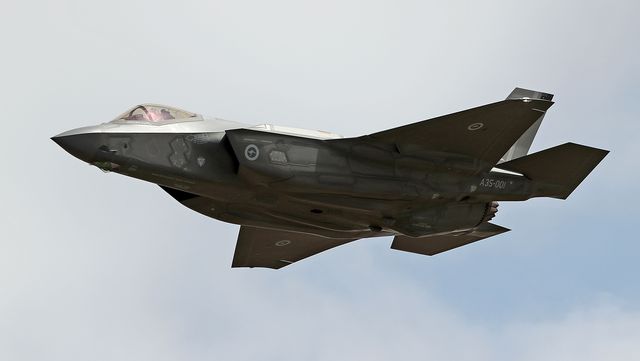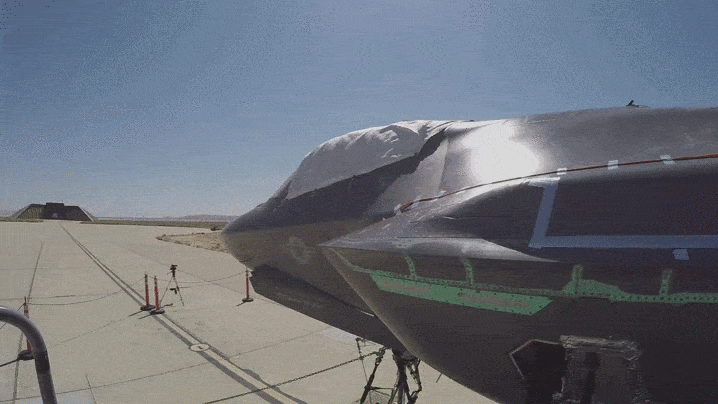Update, July 2018: Since this story was published in August 2016, things have started to look up for the F-35—sort of.
The first Joint Strike Fighters have been declared combat-capable. All three variants—the F-35A for the Air Force, F-35B for the Marines, and F-35C for the Navy, are dropping below the threshold of $100 million per plane as the fighter enters full production.
But it's not all good. The F-35 is still dogged by decisions like the one to build the plane using the strategy of "concurrency," or building the first planes before the experimental design was truly finalized. As of March, barely half the F-35s were flight-ready because many of the older ones needed to be brought up to spec.
The F-35 just flew a victory lap. Last month, three U.S. Air Force F-35As made the Atlantic crossing to appear at the Farnborough Air Show in England (while PM rode along in the tanker that refueled the Joint Strike Fighter). The debut came two years after the F-35 failed to make its first appearance at the international air show following an engine fire.
Recent reports suggest the F-35 Lightning II may have finally turned a corner, overcoming the technical problems that have plagued its development and nearing readiness to serve in the field. It's a big moment for the long-awaited plane, and it's been a long, long time coming. The Joint Strike Fighter was declared operational by the Marine Corps in July 2015; the Air Force just declared initial operational capability (IOC) this week and the Navy hopes to do so by February 2019. If the schedule holds, the F-35 will be baseline operational 18 years after it was selected over Boeing's X-32, and 23 years after the program began.
For over two decades, the F-35 has been the symbol of everything that's wrong with mammoth defense contracts: behind schedule, over budget, and initially, over-sold. How did things get this way, and how did the trillion-dollar albatross come out flying in the end?
There Can Be Only One
The development of the F-35 has been a mess by any measurement. There are numerous reasons, but they all come back to what F-35 critics would call the jet's original sin: the Pentagon's attempt to make a one-size-fits-all warplane, a Joint Strike Fighter.
When the program began in 1996, the JSF was conceived as a way to replace the F-16 Falcon, F-15E Eagle, A-10 Warthog, F/A-18 Hornet, and AV-8B Harrier across their respective roles and missions. The Joint Strike Fighter program called for a common design with three variants to share 80 percent of their parts. There would be the conventional F-35A, the Air Force's plane. There would be the short takeoff and landing (STOVL) F-35B for the Marines. The Navy would get the carrier landing F-35C. At its dawn, the F-35 was projected to be four times more effective than older, legacy fighters in air-to-air combat, eight times more effective in air-to-ground combat, and three times better at reconnaissance and suppression of enemy air defenses. Design goals called for the JSF to be the premier strike aircraft through 2040, second only to the F-22 Raptor in air supremacy.
The F-35 wouldn't just be shared across the branches of the U.S. military; it was to be shared around the world. A coalition of "partner nations" would not only fly and produce the aircraft but support it worldwide. Eventually, eight foreign partners—Australia, Canada, Denmark, Italy, the Netherlands, Norway, Turkey, and the United Kingdom—signed on to invest in and acquire the aircraft. To date, seven have received their first jets and eight have pilots and maintainers in training. Two of the three foreign military sale customers (Israel, Japan, and South Korea) will receive their first jets in 2016.
Stll, we could have seen this coming, and not just because of the technical complexity involved in making a warplane for so many constituents. Long before the delays and overruns that riddles the F-35 program, history was littered with illustrations of multi-mission aircraft that never quite measured up. Take Germany's WWII Junkers Ju-88, or the 1970s Panavia Tornado, or even the original F/A-18. Today the Hornet is a mainstay of the American military, but when it debuted it lacked the range and payload of the A-7 Corsair and acceleration and climb performance of the F-4 Phantom it was meant to replace.
F-35 supporters were undaunted in the face of that evidence, adamant that the technological advances needed to make a do-it-all aircraft for several brances of the military had finally arrived. Back in 2000, I interviewed Lt. General Michael A. Hough of the U.S. Marine Corps, director/deputy director of the Joint Strike Fighter Program from 1997 to 2001. During the interview, Hough thumped the table with his fist, declaring the JSF would not suffer the problems of past multipurose aircraft, which were prone to run over budget and see their progress stall.
The Rocky Years
Things got rocky pretty quickly. The Air Force wanted a stealthy plane, and those stealth requirements drove a JSF design which, at least initially, did not have internal weapons bays. That didn't sit well with the Marines, who would demand their inclusion. This design change would add weight to the F-35. So would the Marines' desire for a vertical takeoff plane, something the USMC demanded because it said it had no alternative replacement for the Harrier. Defense journalist and War Is Boring blogger David Axe observed that "in demanding STOVL capability, the Marines foisted a fat, bulky airframe on the program, even though the Air Force's F-35A didn't really want to be that fat."
Building one plane for three branches wasn't the only place the JSF program ran into trouble. The Pentagon hoped to take advantage of "concurrency": that is, the idea of keeping down costs by building production planes at the same time it was finishing ground and flight testing. Never mind that most aspects of the F-35, from its engines and flight control system to its software and autonomic logistics system, were still in early stages of development at the program's outset and far from finished technologies ready to be integrated. You can imagine what happened. During the flight testing, the military found the F-35 needed structural and electronic modifications. The fact that it had already produced many of the aircraft made the fix far more expensive.
In the decade following 2003, the program faced over a dozen major setbacks. They just kept coming and coming. In 2004, the F-35B was more than 2,000 pounds overweight, unable to meet its performance goals. In 2006, the Government Accountability Office (GAO) warned that, as a result of the policy of concurrent development, retrofitting aircraft with systems that were not fully functional or working as intended could be terribly expensive. By 2013, the cost of retrofitting was put at $1.7 billion.
Starting in 2007, suspected Chinese cyber intrusions resulted in the theft of several terabytes of data related to the F-35's design and electronics systems. This attack and another 2012 hack of BAE Systems (which makes the F-35's flight control software, electronic warfare systems, aft fuselage, as well as its horizontal and vertical tails) forced hardware and software redesigns, adding more cost and delays. From a troublesome helmet mounted cueing system to inadequate ejection seats and logistics software, the F-35 has continued to face challenges.
The mess got so bad that Secretary of Defense Robert Gates removed JSF program manager Maj. Gen. David Heinz (USMC) in 2010 and delayed development even more. Problems assembling the F-35's four-piece wing and structural fatigue in one of the bulkheads supporting the wing on the F-35B, combinged with a strike at Lockheed Martin, forced reduced initial production buys. The cascade of woes nearly resulted in the cancellation of the F-35B in 2010-11. To avoid further delays resulting from design changes, in 2012 the Pentagon accepted a reduced combat radius for the F-35A and a longer takeoff run for the F-35B. The F-35B's estimated combat radius was reduced by 15 percent. (F-35Bs had to refuel 15 times on the recent transatlantic flight.)
Who gets the blame for a 20-year misadventure? In 2013, the GAO's Michael Sullivan asserted that Lockheed had failed to get an early start on systems engineering and had not understood the technologies involved at the program's launch. But a RAND study the same year found the three F-35 variants had drifted so far apart during development that having a single base design may prove to be more expensive than if services had just built separate aircraft tailored to their own requirements from the get-go. And to this the fact that enormous defense projects almost always go over-budget and you've got a recipe for the start-and-stop, muddled first two decades of the F-35.
The Price Tag and the Promise
Cost estimates for the F-35 have changed yearly over the past 15 years. It's safe to say, though, that the program is the most expensive in U.S. history (so far), pegged at more than $320 billion in 2012. In 2014, the GAO found that the F-35 fleet would have operating costs 79 percent higher than the aircraft it was to replace.
A 2015 Pentagon Selected Acquisition Report said that program costs had increased 43 percent from 2001, including unit cost (up 68 percent). The report added that the F-35A's cost per flying hour is $32,500 while the F-16C/D is $25,500. Private analysts have called the F-35 a "money pit," and argued that the purpose of Lockheed's extensive national and global supplier base—which includes 1,300 suppliers in 45 states and nine foreign countries—was not so much to realize logistics efficiency and security, but to make sure the Joint Strike Fighter was too big to fail.
They succeeded. The F-35 may be one of the most derided and controversial warplanes, but it's here, nearly ready to go into service in force. That's a good thing. Frankly, we need the F-35. The average age of current USAF airframes stands 27 years, and it's nearly as bad in the Navy. Decades-old Marine airplanes are being brought back from the boneyard. As a fifth-generation aircraft, the F-35 offers new combat capabilities and information exploitation. It will work with the F-22 and our 4th generation fighters such as the F-18 and F-16 to "kick down the door" in defended environments.
The F-35 is, at least so far, a jack-of-all-trades and master of none. We have paid a steep price for it, the full accounting of which has yet to be reckoned.
Let's hope it was worth it.















